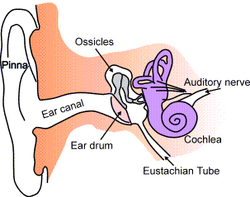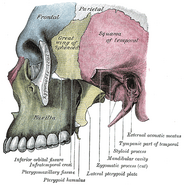Assessment |
Biopsychology |
Comparative |
Cognitive |
Developmental |
Language |
Individual differences |
Personality |
Philosophy |
Social |
Methods |
Statistics |
Clinical |
Educational |
Industrial |
Professional items |
World psychology |
Biological: Behavioural genetics · Evolutionary psychology · Neuroanatomy · Neurochemistry · Neuroendocrinology · Neuroscience · Psychoneuroimmunology · Physiological Psychology · Psychopharmacology (Index, Outline)

Anatomy of the human ear.
- Main article: External ear
The ear canal, or external auditory meatus, is a tube running from the outer ear to the middle ear. The ear canal extends from the pinna to the eardrum and is about 26mm in length and 7 mm in diameter.
Description and acoustic characteristics[]
The outer foundation of the ear canal is cartilage covered with skin that contains hairs and glands that secrete wax. The hairs and wax (cerumen) help prevent foreign bodies, such as insects or dust, from entering the ear canal.
The ear canal protects the eardrum and acts as a resonator, providing about 10 dB of gain to the eardrum at around 3,300 Hz. The net effect of the head, pinna, and ear canal is that sounds in the 2,000 to 4,000 Hz region are amplified by between 10 and 15 dB. Sensitivity to sounds is greatest in this frequency region and therefore excessive noise in this range is the most likely to cause hearing damage.
The external auditory meatus is formed from the groove (cleft) of the first branchial arch.
Size and shape[]
The ear canal is approximately 26mm long and 7mm in diameter. Size and shape of the canal vary among individuals. This is an important factor to consider when fitting hearing protectors.
Additional images[]
References[]
Sensory system: Auditory and Vestibular systems (TA A15.3, GA 10.1029) | |||||||||||||||
|---|---|---|---|---|---|---|---|---|---|---|---|---|---|---|---|
| Outer ear |
Pinna (Helix, Antihelix, Tragus, Antitragus, Incisura anterior auris, Earlobe) • Ear canal • Auricular muscles | ||||||||||||||
| Middle ear |
| ||||||||||||||
| Inner ear/ (membranous labyrinth, bony labyrinth) |
| ||||||||||||||
| {| class="navbox collapsible nowraplinks" style="margin:auto; " | |||||||||||||||
| |||||||||||||||
|}
| This page uses Creative Commons Licensed content from Wikipedia (view authors). |
